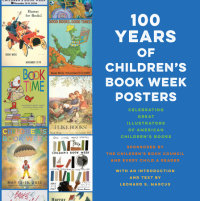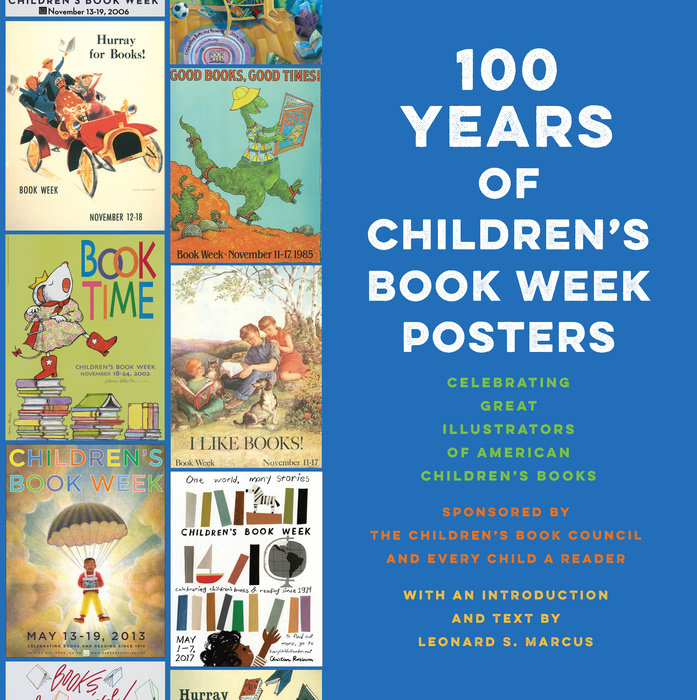100 Years of Children's Book Week Posters
Celebrate a century of children's book illustration!
For families, art lovers, and history buffs alike, Leonard S. Marcus's visual history tour of 100 years of children's book illustration gathers in one glorious volume the posters of the annual Children's Book Week!
Featuring work from early luminaries such as N. C. Wyeth and Marcia Brown to more contemporary illustrators like David Wiesner, Mary GrandPré, Christian Robinson, and Jillian Tamaki, this beautiful collection showcases the conceptual and iconic images that have defined children's books for generations of young readers.
While the posters within these pages are linked in their resounding advocacy for young people's literacy, they are distinguished by the styles and mediums of their creators and by the historical, social, and cultural influences of their times. Renowned historian Leonard S. Marcus traces these developments in the children's book field with incisive descriptions to accompany each poster.
Children's Book Week has grown over the past one hundred years from a modest grassroots effort to a full-throttle nationwide annual celebration of literacy and the pleasures of reading. The posters in this book beautifully emphasize Book Week's mission, with slogans such as "Build the Future with Books," "Get Lost in a Book," and "One World, Many Stories."
An Excerpt from100 Years of Children's Book Week Posters
“FRIENDS,” warns the fast-talking flimflam artist of Meredith Willson’s The Music Man. “Ya got trouble. Right here in River City!” It is 1912 in America’s heartland, and in a prim midwestern town where a pool hall has just opened for business, the good citizens of River City are up in arms out of fear for their children’s future. It was a scene that repeated itself for real in countless turn-of-thetwentieth-century localities as Americans embraced the new industrial economy, moved to cities, pondered the bewildering pace of social and economic change, and prepared as a nation to take their rightful place on the world stage.
While the expanding American middle class prospered in 1900 as never before, large segments of the nation’s population, including millions of newly arrived immigrants, lived in abject conditions that reformers such as Jacob Riis, Lincoln Steffens, and Jane Addams vowed to remedy. These and other reformers, and their allies in government, gave special attention to the needs of children, pressing for improved infant nutrition and pediatric care, enforceable child labor laws, and greater opportunities for public education. It was against this backdrop of socially concerned activism that public librarians decided, after debating the question, that they, too, had an important role to play in the lives of the nation’s children.
Libraries that had once posted “No Dogs or Children Allowed” signs now opened their doors to young people, a category of patrons that the New York Public Library defined liberally as including anyone old enough to sign a registry book and present a clean pair of hands. Another crucially important innovation was the introduction of the world’s first children’s reading rooms staffed by the world’s first trained children’s librarians. One rationale for creating the beautifully appointed rooms was the desire to provide impressionable young people with the best possible first experience of reading. But the rooms were also meant to limit children’s access to books deemed inappropriate for them, the racy novels of Balzac, for example, whose very name is whispered by fretful River City–ites with cartoonish dread.
Librarians made their historic commitment to children at a time when American juvenile publishing was far less structured than it later became. To some critics, the industry was little more than a Wild West of profit-driven firms cranking out lurid dime novels and other popular series fiction featuring action-oriented plots, archvillains, and heroes too strong or lucky to have much value as role models. Believing that character building was children’s literature’s primary role, the librarians made it their business to seek out what “good” books they could find, to actively encourage publishers to bring out others, and to spare children exposure to “trash.” They hoped that parents would follow their lead.
Between 1912 and 1915, the Boy Scouts of America, a new youth organization premised on character building, pledged to do its part as well. The Scouts had a full-time staff librarian named Franklin K. Mathiews whose job it was to shape the reading habits of its boy members. Mathiews and his colleagues “strictly censored” submissions to the Scouts’ official magazine, Boys’ Life, so as to keep out all “harmful material,” as one typical ad assured parents, and they issued occasional lists of “Books Boys Like Best” for national distribution. In 1915, in a fiery speech delivered at the American Booksellers Association’s annual convention, Mathiews went further, reaching beyond the scouting community to remind the hundreds of booksellers in his audience of their moral obligation to educate the next generation. He proposed that they join forces with him in an all-out literacy campaign that would also harness the collective efforts of the nation’s civic and religious leaders, parents, teachers, librarians, journalists, and others. Ours is a day, he quoted a prominent librarian friend as saying, “when parents are frantically protecting children from the deadly housefly, the mosquito, the common drinking cup and towel.” Should not all good Americans exercise the same degree of vigilance about the books to which they exposed their children? Mathiews proceeded to sketch the outlines of the annual observance he envisioned, gamely noting its commercial benefit for retailers as a kickoff to the holiday season. The crowd roared its approval as he yielded the floor.
Few booksellers of the time had much firsthand experience with the juvenile trade. Shops specializing in children’s books were exceedingly rare, and most general-interest bookstores and department stores stocked juveniles, if at all, only at Christmastime. It was not clear just what the booksellers would be willing to do. But Mathiews had two powerful allies. Anne Carroll Moore was the New York Public Library’s crusading superintendent of the Department of Work with Children, and Frederic G. Melcher, the visionary editor of what was then called the Publishers’ Weekly. Each of the “Three M’s,” as the group came to be known, had a large constituency that complemented the others, and although progress was slow at first, and the project had to be tabled altogether during the years of America’s participation in the First World War, the partners continued to make plans. Finally, the announcement went out that Children’s Book Week would launch as a national event on November 10–15, 1919. The official slogan for the occasion—“More Books in the Home!”—had been selected to bring along the booksellers, and Jessie Willcox Smith, America’s most famous woman illustrator, had agreed to design the poster on which it would appear. Smith’s poster and a list of books recommended for holiday gift-giving were to be the campaign’s centerpieces. But just as important were the hundreds of local events to be organized at the grassroots level in cities and towns across America, for which the committee furnished general guidelines. Andrew Carnegie had employed a similar strategy when he agreed to donate public library buildings to more than 2,000 communities whose residents were willing to raise the funds needed to operate the building and fill its shelves with books. Poster sales became a handy way to gauge regional interest in the observance. That first year, bookshops, libraries, and schools ordered 3,000 posters. By 1923, orders had risen to 15,000. Year by year, the number continued to climb.

